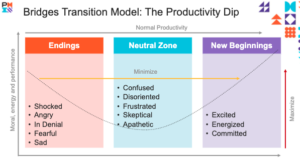Appetite for Disruption
It’s no secret that we live in a time of uncertainty and change. And any study in human psychology and behavior will tell you that, as human beings, we naturally dislike and avoid change. Why? It’s uncomfortable. It’s uncertain. It’s disruptive—and all of that can be unsettling.
In fact, according to a survey conducted by Forbes Insight and the Project Management Institute (PMI), 85% of survey respondents of over 500 executives stated that change management is necessary during times of disruption.
Although we might not like change and try to avoid it at all costs, it is inevitable. Learning to embrace change allows organizations to become more agile, adaptive, and resilient, and even gain a competitive advantage.
However, much like becoming agile, embracing change requires shifting the organizational cultural mindset from “this is how we’ve always done things” to a continuous improvement, corrective action, and “always learning” mindset. This also means updating regulations, procedures, and breaking down organizational siloes.
We know, we know… easier said than done.
In this article, we will dive into what exactly change management is, why it’s necessary for organizations, and how to adopt a change management model and plan to disruption-proof your organization in the future.
What is Change Management?
The Project Management Body of Knowledge (PMBOK) Guide, Seventh Edition, by the Project Management Institute (PMI) defines change management as “a comprehensive, cyclic, and structured approach for transitioning individuals, groups, and organizations from a current state to a future state with intended business benefits.”
Change management can mean two different things, however, depending on the change requirements, the two might be interrelated. Change comes in two different forms:
- A change that impacts a project, such as a change in requirements, performing a corrective action, or addressing a defect.
- A change in process that impacts people, such as a change in policy, procedure, or system.
Change management involves processes and procedures, including how change is conceived, communicated, managed, controlled, and iterated.
3 Areas of Change
As we mentioned briefly above, change is inevitable. It can occur at various levels, and sometimes all levels. When change happens, it affects these three areas:
- People side of change
- Project side of change
- Organizational side of change
When planning for change, leaders need to ask the following questions:
- What is the source of the change?
- Who does it impact?
- What are the risks?
- What do we need to communicate? Who do we need to communicate to? And how?
Do We Really Need Change Management?
The answer is YES. And here’s why…
- Increases probability of project success
- Reduces team member resistance
- Builds resiliency across the organization
- Avoids project scope creep
- Reduces decreased productivity and quality
3 Types of Change Management Models
There are several different types of change management models. Depending on the organizational culture and other enterprise environmental factors (EEFs) within your business, you might discover that one particular model is better suited for your team than another.
Here are three different types of change management models you can explore:
1. ADKAR Model
The ADKAR Model focuses on five sequential steps that individuals experience when adapting to change:
- Awareness – Why the change is necessary
- Desire – Developing the desire to support change
- Knowledge – Understanding how to change (adopting new processes, systems, responsibilities, and work habits)
- Ability – Embracing hands-on application and experimentation as well as understanding where and who to go to for support
- Reinforcement – Sustaining the change
2. Kotter’s 8-step Process for Leading Change
The eight-step process by John Kotter is a top-down model for leaders who spearhead change that transforms an organization:
- Create urgency – Identify potential threats and opportunities that drive the need for change.
- Form a powerful coalition – Identify and assign change leaders to influence groups and team members.
- Create a vision for change – Identify and document the values central to the change.
- Communicate the vision – Share the vision for change with others, and apply it to the entire organization.
- Remove obstacles – Obstacles are inevitable. Face and address all obstacles head-on.
- Create short-term wins – Identify quick and easy wins to build momentum.
- Build on the change – Set goals for continuous improvement.
- Anchor changes in corporate culture – Empower others to embrace change, share success stories, and continue communicating the vision.
3. Bridges Transition Model
This particular model is more people-focused and is specifically centered around recognizing and addressing the psychological phases that an individual goes through during a period of change.
Ending, losing, and let
- The “neutral” zone – People adjust to new ways of working and thinking. Productivity is decreased during this phase.
- The “new beginning” – People accept and embrace change and are energized and enthusiastic about change. Productivity increases during this phase.
How to Develop a Change Management Plan
Repeat after me: Effective change management involves everyone in the organization.
The key word here is everyone.
This doesn’t mean just project team members or leaders. It must include executive leadership, Board members, and all other stakeholders.
That said, not every organization is ready for change. Before developing a change management plan, first assess the organization’s readiness for change. This involves assessing the organization’s capacity, commitment, and culture.
If the organization is ready for change, it’s time to select a model and develop a change management plan. This involves considering the vision for change, the desired impact, and how the change will be communicated.
So, what does all this look like in practice? Here are some steps to follow:
Step 1. Define and outline the change activities.
Ask yourself, what must we do to adopt or roll out the change? What are these tasks and activities? Who will own them?
Step 2. Communicate the change.
Determine the best way to communicate change. Is it by email? A team meeting? Advanced communications is key here.
Be sure also to communicate the source of change. Why is the change happening in the first place?
- Environmental/world
- Financial
- Organizational/structural
Then, focus on communicating the state of the change, such as:
- Current state – how things are done today
- Transition state – how to move from current to future
- Future state – how things will be done tomorrow
Step 3. Execute and reinforce the plan.
This step involves listing out the necessary tactical steps to successfully transition the team and organization to the intended future state.
Step 4. Monitor, measure, and control change implementation or delivery against the original plan.
How is change being rolled out? What is the progress? How are we measuring success?
Step 5. Include continuous improvement activities.
Continuous improvement is iterative. It’s about operating in “always learning” mode, and understanding what the team and organization can be doing better and where they can improve.
Remember, embracing change is continuous, and when executed properly, leads to sustainability within the organization.
Future-proof Your Organization
Digital transformation forced companies and organizations to change, regardless of whether or not they were ready for it. As mentioned above, the key is to embrace change rather than avoid it. All in all, dealing with change is difficult, but not impossible. With a well-documented change management strategy, including a thorough communications plan, and a change management model that change leaders and agents feel best fit their team and organizational culture.

